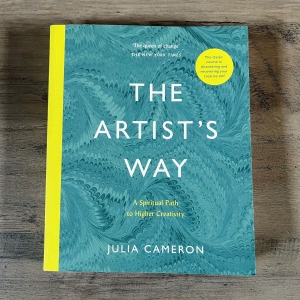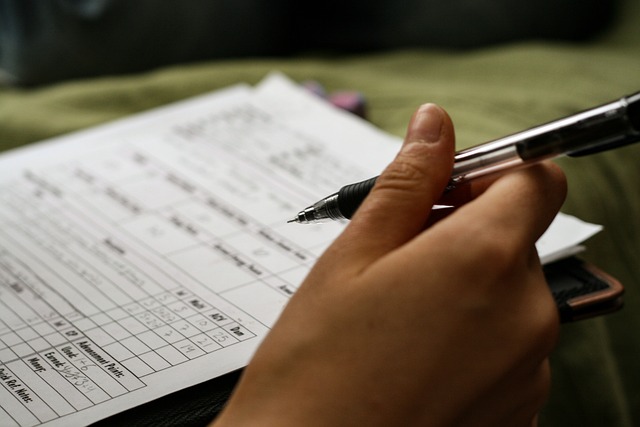
After examining some major creative blocks over several weeks, week 7 shifts the discourse by looking into the kind of mindset we should embrace for creativity. With these insights in mind, Cameron returns to dissecting creative blocks associated with time in week 8. Much like week 4, week 8 represents a turning point as we begin to look at healing our artistic wounds.
Week 7: Recovering a Sense of Connection
Listening
Providing a welcome respite from reconsidering our negative conditioning, week 7 focuses on practicing what Cameron defines as the right attitudes for creativity, beginning with listening. Cameron reminds us that we’re strengthening our listening skills with morning pages and the artist’s date, which respectively helps us hear past our inner censor and tap into inspiration. Describing inspiration as “getting something down” instead of “doing”, she asserts that another party (God, the universe) accomplishes the “doing”. Connecting inspiration to listening, Cameron states that artists are actually listening when we are “getting something down”. When artists are “in the zone”, they are listening for the next artistic step.

Cameron likens such listening to delving below “the surface of our normal consciousness”[*] or dialing into a “stream of inspiration” like a radio. Artists use these ideas but, as Cameron emphasizes, it’s more like “taking dictation than anything fancy having to do with art”[†] as artists are “more conduit than the creator of what we express”. Cameron supports this concept by quoting several expressions (“the brush takes the next stroke”) and artists (eg, Michelangelo) who share her view that guiding force(s) assist us with creating art. Whether this interpretation suits you or not, Cameron’s clearly intends to alleviate any stress we might be feeling about finding our inspiration. For her, it’s important that we’re in the moment listening as we create, knowing that universe will help us.
Embracing the Imperfect
Perfectionism is not a quest for the best.
Perfectionism, as Cameron quickly makes plain, is a wrong approach to art, one that diverts artists from “getting it down” to “getting it right”. In doing so, perfectionism slows a project’s momentum and dampens the joy of creating. It also sets unrealistic expectations for both early drafts (which should be unpolished) and finished pieces (as perfect is impossible). Trapped in a perfectionist cycle, an artist might never reach the project’s close. Cameron’s tough love attitude makes an appearance here, as she castigates perfectionists for claiming humility instead of the egotism that she believes inspires them. This comment should be taken with a grain of salt: fear, not pride, seems to drive unhealthy perfectionism, and perfectionism itself may be associated with mental health disorders.
Taking Risks
We deny in order to do something well we must first be willing to do it badly.

Artistic recovery requires us transform our wish to be creative into being creative, something that involves risk. As Cameron observes, we excel at avoiding risk. Lingering at past triumphs, we claim we can’t try new things given our limitations. But, as she tartly retorts, we’re really unwilling to try without being assured that our efforts will be perfect. If we want to become proficient at our craft or expand our artistic range, we must accept that our initial undertakings will be imperfect. Cameron, therefore, recommends we drop this unrealistic expectation. Furthermore, she endorses taking risks for their own sake, because they let us redefine our limits and make it easier to continue taking more risks that may work out. Cameron provides a brief exercise here to encourage us to think about what we might attempt if we were unworried about being “good” at them.
Jealousy: An Indicator of Artistic Desire
Much like anger in week 3, jealous is not a “right attitude” for creativity but an emotion that covers other feelings. Unmasked, however, jealousy offers powerful insights into what we desire as artists—knowledge that we can utilize to live more creatively. As Cameron explains, jealousy hides our fear and resulting frustration when we watch other artists doing or being admired for things that haven’t yet mustered the courage to do. As a “stingy” emotion, it falsely persuades us that only an artist can be the “best” when there’s space for everyone. It similarly blinds us to our alternatives, namely that we can escape this cycle by acting on our desires. Cameron provides two exercises to help us conquer our jealousy by taking “antidote” actions (The Jealousy Map) or find ways to soothe and encourage our inner artist child (Archaeology).

Week 8: Recovering a Sense of Strength
Most would agree that time is a major creative block. Cameron has at least indirectly dealt with issues of time management when she urged us to explore how we occupy ourselves.[‡] In this week, she intends to address other time-related issues as they also serve as creative blocks. Relating heavily to some “wrong attitudes” and unrealistic expectations that week 7 illustrated (notably, perfectionism), this week seeks to unpack these attitudes as we concurrently move past artistic wounds.
Artistic Wounds and Survival
Cameron investigates artistic losses from the perspective of survival. In an artist’s career, both personal as well as artistic setbacks will occur. Cameron points out the danger of turning such moments into “secret losses” that, left unprocessed, could become artistic blocks. Before we attempt to convert these “losses into gains” (see below), they need recognition and time to be mourned. By respecting our losses, we protect our future as artists.

Meditating further on artist’s wounds, Cameron reiterates that bad criticism (weeks 3 and 2) is among the worst wounds because such critiques imply the work or artist somehow is faulty without evidence. She also briefly discusses self-inflicted wounds. Such wounds, caused when artists refuse artistic opportunities, typically become sources of regret. Promising to further review this topic in week 9, Cameron recommends that we, for now, mourn these losses.
Malevolent Mentors
Alongside bad criticism, Cameron also condemns those who carelessly wield their critical powers. She strongly believes that mentors act as authority/ parental figures to young artists who place their trust in these guides’ judgement, with significant harm done when these teachers fail to fulfill their duty.[§] Lacking resilience, support or the experience to seek other mentors and/or opinions, some surrender their artistic aspirations altogether while others become shadow artists (week 1).

Cameron, having detailed how such poor mentoring occurs in childhood, takes pains to provide examples of how unwary young artists may encounter harmful mentors in the university setting and beyond (The Ivory Power). Sandwiched between her illustrative examples, however, are her sweeping generalizations about academia and intellectualism that lean into overstatement.[**] Her larger point—that academics should nurture young artists at their level—however, is indisputable.
Gain Disguised as Loss
The key here is action.
Artistic losses, however, are more than wounds from which we need to heal. They are also lessons. Cameron assures us that we can use such losses to guide us when deciding how we should proceed after a loss. Asking how losses help us and our craft can reveal new directions and approaches that we might have otherwise neglected. Drawing from her own experiences, she emphasizes the importance of eschewing self-pity (“Why me?”) that leads to artistic blocks or setbacks in favor of determining the next move. Searching for alternatives is a sure path to developing a diverse artistic career.
Age, Time, and the Creative Process
I’m “too old” is an evasive tactic. It is always used to avoid facing fear.
As blocked artist, we often believe there’s a “right” age to be creative—one must be either young and crazy or old and eccentric enough to take up art. Citing “crazy” as the precondition for creative excursions reveals the truth. Age is less problematic than our egos, as we dislike revealing our inexperience or fear looking foolish. This same fear also causes us to question the time we invest in learning new skills or spend working on art.

Time is a touchy subject because we want results that justify our efforts. Focused on product, we might bypass the pleasures of exploring artistic sidelines or new skills, which misses the point of creating. Creativity, Cameron explains, is about “doing” not being “done”. There is always more to learn about practicing our craft. Even when we complete projects, they will suggest further avenues to study. Viewed properly, the artistic process is a continuous one of creating and learning.
Filling out the Form
Large changes occur in tiny increments.
Cameron’s emphasis on centering the creative process includes some practical advice on getting started. Aware that recovering artists often rush towards their goals or impulsively yield to subconscious beliefs that their lives must significantly alter before they embrace their creativity, Cameron advocates that we take some baby steps. By now, Cameron exhortations to pace ourselves as we work through creative blocks/limitations should be familiar. Here, she details her reasons for taking one’s time.

Filling the form is shorthand for breaking our loftier goals (however ambitious they may be) into small, daily tasks. In addition to being a means to manage projects, performing incremental “next available steps” affords us immediate success that sustains our progress. In contrast, “big picture” thinking fuels our anxiety about achieving results, leading to procrastination and discontent with our constraints. Similarly, dramatic lifestyle changes and their attendant difficulties distract us from creative work. By filling the form, we employ our current resources and move forward steadily. Cameron closes the chapter with an activity that again scrutinizes (Early Patternings) how earlier conditioning may continue to block us.
Some Closing Thoughts
Given the motivational nature of weeks 7 and 8, it’s unsurprising to see familiar themes emerge. Perceived through Cameron’s unique lens, some fresh perspectives and original ideas pop up, which make repeating the advice bearable however discursive her material may be.
Notably, Cameron’s right attitudes weave these familiar elements into the means for reframing our thinking about creativity that’s often actionable.[††] Helpfully, these ideas also build on each other. For example, perfectionism—the section that contains the most conventional thinking—becomes a thread that runs through week 7 into week 8 as she identifies how it interferes with inspiration’s flow to how adopting anti-perfectionism grants us the humility to be a beginner at any age. Ideally, I would have been preferred reading the perfectionism section couched in more positive terms, as we’re advised on what to avoid in lieu of what we should do (my headers in week 7 indicates how that might look). Particularly praiseworthy, though, is how she turns jealousy, a hateful little emotion, into a tool that detects our unrealized artistic dreams, one that points out the risks we need to take.

Week 8’s return to deconstructing our negative conditioning is a bit drearier, as it pokes at our artistic wounds (to heal them!) and revisits how we earned a few of those wounds. Least successful is the section on academia, which could’ve been more concise and far more nuanced. This week shines, though, when Cameron shares how to both mourn and learn from our artistic wounds. Filling in the form, as part of her discussion on embracing the artistic process, illuminates a concrete plan for moving on past losses that help us reach larger creative breakthroughs. While I still have quibbles with some of Cameron’s ideas (see the footnotes), these weeks provide the solid reasoning that should persuade us to question why we aren’t creating.
Are you working on improving your creativity with The Artist’s Way? How far have you gotten? If not, would you try it? I’d love to hear why or why not.
NOTES
[*]Potentially, the collective unconsciousness or an individual’s subconscious (as Jackson Pollock, an artist referenced in week 7, claimed about his work).
[†]I dislike how this comparison diminishes the artist’s role to that of an amanuensis, given the skillsets artists cultivate.
[‡]Cameron cites multiple ways in which we squander time (week 2’s crazymakers, week 4’s media deprivation and week 5’s obligations) that could be otherwise used to create art.
[§]I appreciate Cameron’s desire to highlight both the betrayal and insidious emotional abuse wreaked by these teachers, but I wish she hadn’t linked this to sexual abuses (particularly incest) given the other abuses they bring to mind.
[**]Universities aren’t for everyone, as both brilliant self-taught artists and other instructional venues for artists exist. However, I’m not persuaded that universities are ill-equipped to support artists so much as they, too, possess some bad apples on staff.
[††]Bonus points for shoeing in how indispensable her own tools, morning pages and the artist’s date, are to creativity.


Reblogged this on the writer is a lonely hunter and commented:
Inspiring lessons from Rita E Gould on how to use Julia Cameron’s The Artist’s Way to heal artistic wounds.
LikeLiked by 1 person